Munitions Typology
Introduction
In the aftermath of chemical weapons attacks, the remnants of munitions – ranging from small shards to large metal hulks – are usually the first and most important pieces of material evidence recovered from the scene. This is especially true in Syria, where most chemical attacks are executed using domestically produced munition designs, including weapons containing highly volatile and dangerous nerve agents. Whether spent or intact, munitions tell us a lot about the nature and evolution of the Syrian chemical weapons program as well as its operational integration into the government’s conventional war machinery.
In our review of hundreds of reported cases, we found that certain munitions are closely associated with specific attack patterns by Syrian government forces. These consistencies help us to pinpoint particular military units as the likely perpetrators of each attack. By examining these cases, we are able to connect material evidence recovered from attack sites across Syria to government forces as they move from front line to front line. For further details on the patterns of chemical weapons use, see our report Nowhere to Hide.
This munitions typology is based on a review of existing investigations into dozens of chemical weapons attacks as well as a collection of primary source imagery related to 53 incidents compiled by the research team. We aim to provide a reference guide for understanding the evolution of the Syrian chemical weapons complex.1 For those seeking justice for war crimes committed by the Assad regime, we hope this typology can serve as a starting point for investigators to draw connections between material evidence from impact sites and broader patterns of violations, as well as likely perpetrators of chemical weapons attacks. This typology is not exhaustive, but focuses on those munition types which have been attributed to specific chemical attacks and are backed by clear evidence.
Munition Fact Sheets
Download PDFSarin Grenade
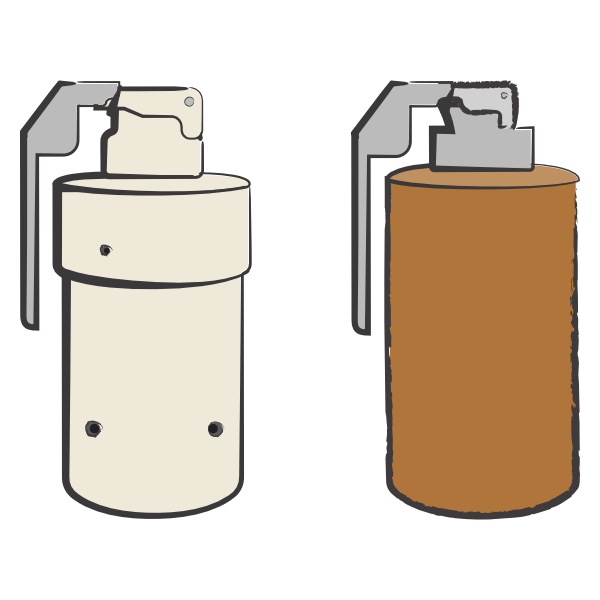
Sarin Grenade
- Sarin Air-launched
A repurposed hand grenade originally designed for riot control agents and converted to deliver Sarin gas.
Volcano Rocket
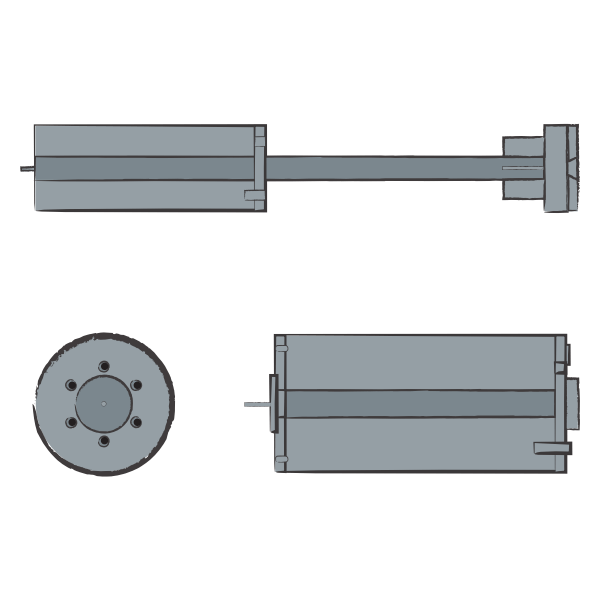
Volcano Rocket
- Sarin Ground-launched
A non-standard artillery rocket derived from conventional improvised rocket-assisted munition (IRAM) designs.
M-14-S Rocket
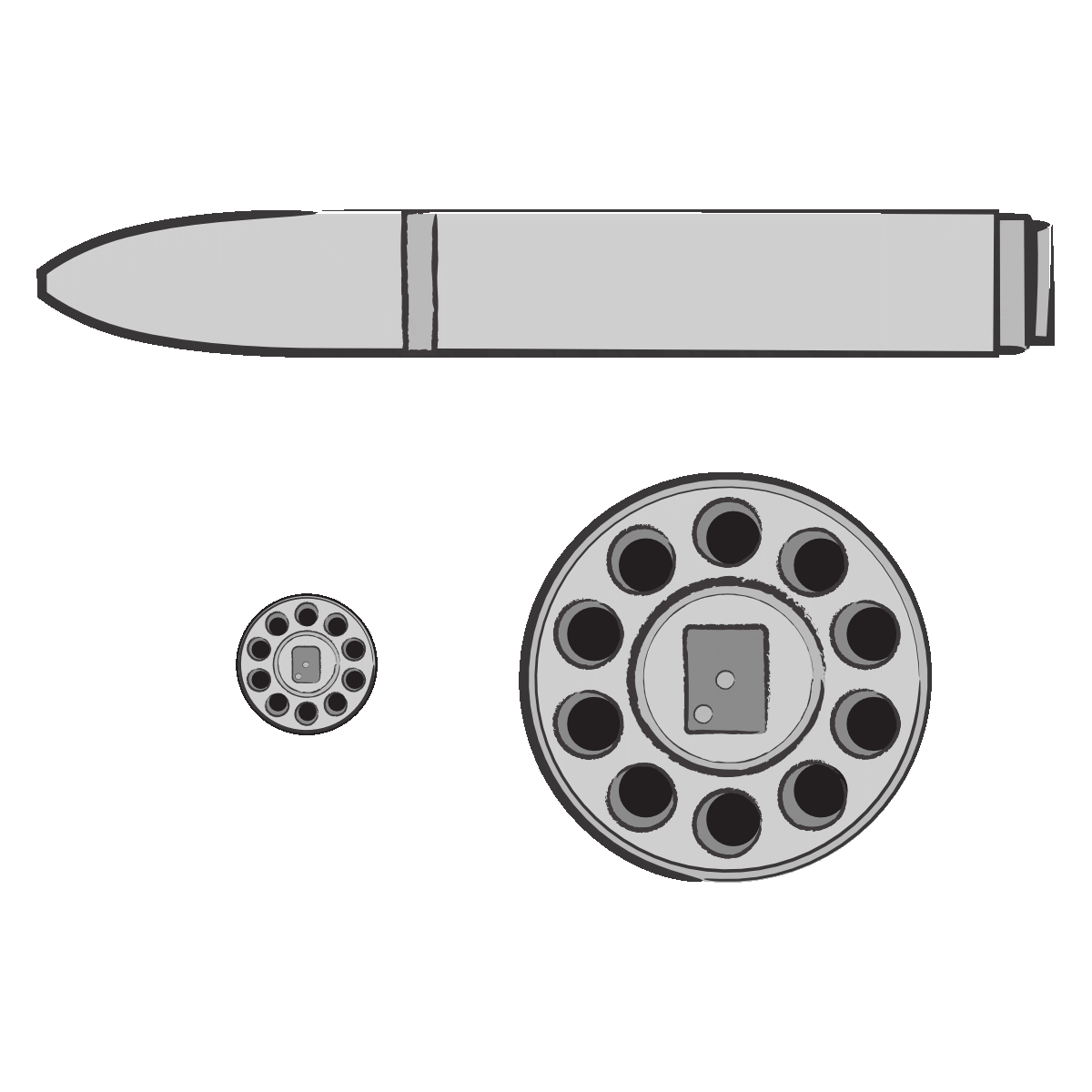
M-14-S Rocket
- Sarin Ground-launched
A spin-stabilized artillery rocket originally manufactured by the Soviet Union.
Barrel Bomb
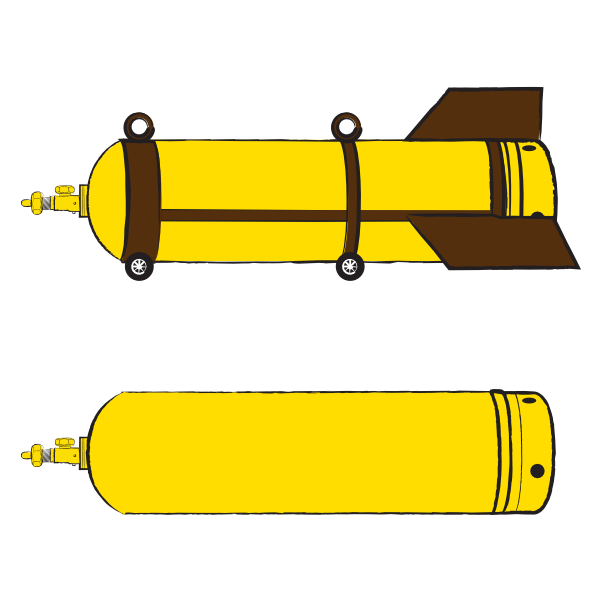
Barrel Bomb
- Chlorine Air-launched
An improvised air-delivered chlorine munition with at least seven identified subtypes, split here between an earlier iteration and the more recent barrel bomb design in use since 2016.
Golan Rocket

Golan Rocket
- Chlorine Ground-launched
An improvised munition based on Iranian-made 107mm surface-to-surface rockets. Its design stems from conventional improvised rocket-assisted munition (IRAM) designs used in Iraq in the mid-2000s.
M4000 Aerial Bomb
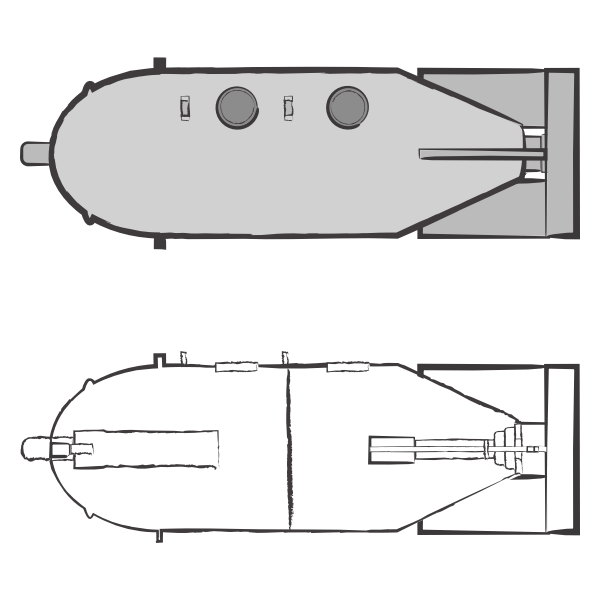
M4000 Aerial Bomb
- Sarin Air-launched
An unguided aerial munition derived from Soviet-era conventional aerial bombs with adjustments to accommodate chemical agents.
Sarin Grenade
Sarin grenades – also referred to as helicopter-dropped Sarin ‘packages’ – are compact, improvised munitions containing a small load of active chemical agents. Forensic evidence from chemical attacks linked to this munition type reveals that the Syrian government created Sarin grenades by repurposing hand grenades designed for riot control agents to deliver Sarin gas.

Physical Characteristics
Evidence from three impact sites and eyewitness accounts following a chemical attack in Saraqib, Idlib in April 2013 suggests that Sarin grenades were dropped from Syrian government helicopters. The individual grenades appear to have been lodged into cinder blocks, which broke upon ground impact and released the grenade’s safety lever, allowing the chemical agent to disperse. 2
Two types of grenades were recovered from the confirmed attack site in Saraqib on 29 April 2013. 3 The first grenade, which was recovered unexploded and subsequently smuggled out of Syria for examination by French forensic experts, had a metal casing and a design similar to common tear gas grenades used for riot control. According to the findings of the French investigation, each grenade carried 100 milliliters of Sarin – about 1,000 to 2,000 times the amount considered lethal by inhalation 4 – that had a chemical fingerprint matching the Syrian government’s stores and its production method for Sarin.
A second grenade type was recovered from another impact site in Saraqib, as well as in the aftermath of the 13 April 2013 attack in Sheikh Maqsood, Aleppo. While similar in size to the first grenade, this version had a plastic casing which appeared burnt or corroded upon recovery. This grenade was topped with spring release levers similar to those seen on the first grenade with a metal casing. In addition, this second grenade appeared to have four filling holes distributed around its body. Debris at the impact site in Sheikh Maqsood suggests that these grenades were also lodged within cinder blocks to avoid their release before impact.
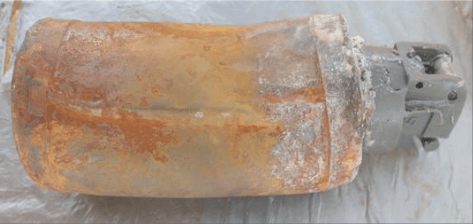

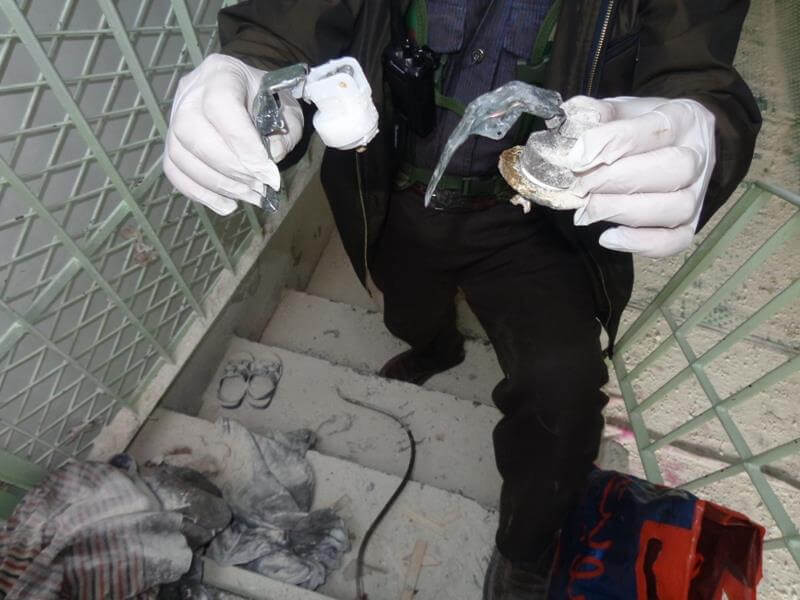
History & Context
Investigations have linked Sarin grenades to at least two chemical attacks in spring 2013: in Sheikh Maqsoud, Aleppo on 13 April 2013 and in Saraqib, Idlib on 29 April 2013. The attack on rebel-held Sheikh Maqsood reportedly left 14 dead 5 and roughly 20 injured. 6 According to media reports as well as evidence collected by the French Ministry of Foreign Affairs, Syrian Arab Air Force (SyAAF) helicopters dropped three Sarin grenades over three separate impact sites in Saraqib, killing one person and injuring at least 20 more. 7 This attack was part of the Syrian government’s effort to recapture parts of northern Hama following the advance of Syrian rebels and Islamist factions in the area. Over the next few years, Saraqib and its surroundings were repeatedly targeted with chemical attacks. The recovery of an unexploded munition and the collection of tissue and soil samples from the attack in Saraqib provided the international community with the first reliable proof of chemical weapons use in Syria.
Volcano Rocket
So-called Volcano rockets are one type of locally produced, improvised surface-to-surface munition used by Syrian government forces. According to our database, a variant of these recognizable improvised rocket-assisted munitions (IRAM) delivered Sarin in at least two known attacks in 2013.

Physical Characteristics
Volcano rockets come in three different sizes, one of which contains a chemical variant for the delivery of binary Sarin. The consistency of their design and further evidence retrieved from government factories suggest that these Volcano rockets are industrially produced inside of Syria. The Syrian military has been recorded in local media using Iranian-designed 333mm launchers – the most common of which is the “Faliq-2” launcher, a multiple-rocket launching system – against different front lines throughout the country.
An example of the Volcano rocket’s chemical variant was recovered from the 21 August 2013 attack site in Eastern Ghouta. This Volcano rocket type has an engine measuring approximately 134 centimeters and a warhead of approximately 70 centimeters. 8 This Volcano rocket’s diameter is approximately 36 centimeters. 9 At the end of the engine are six stabilizer fins arranged in a circle under a metal ring. The warhead – which is larger than the rocket’s engine and has a fuse thread at its top – is attached to the engine tube with 12 bolts. These rockets are marked and numbered in red: this distinguishes them from the Volcano rocket’s high-explosive variants, which are marked with black numbers. The chemical rocket’s payload includes a thin-walled container inside the warhead, which is loaded via a plughole on its side. The warhead’s container can hold anywhere between 50 and 60 liters of chemical agents. To distribute the chemicals, a small central tube loaded into the payload breaks the thin-walled container upon impact. However, the Volcano rocket’s design is not aerodynamic, despite its spin stabilization mechanism. For this reason, Human Rights Watch has declared the Volcano rocket to be “relatively short ranged and not capable of accurate targeting.” 10 Despite its high potential for destruction, the Volcano rocket’s smallest explosive version – a 107mm rocket – has a range of only a few hundred meters, while the 122mm Volcano rocket has a range of around 2 to 2.5 kilometers, and the larger 220mm rocket has at least a 2.7 kilometer range. 11
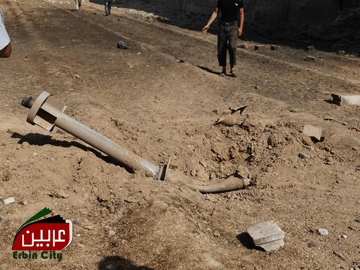
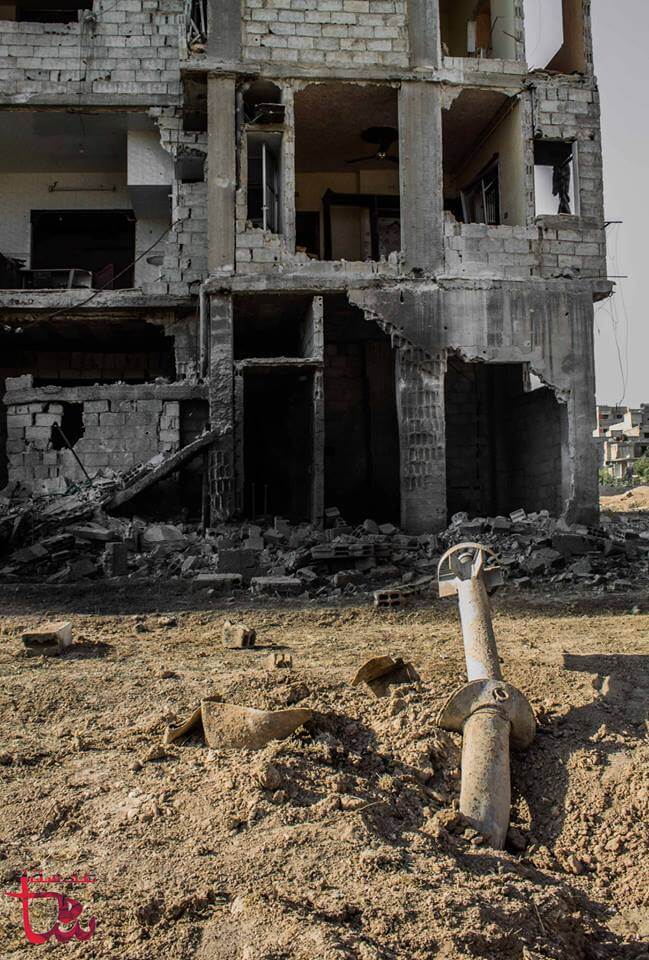
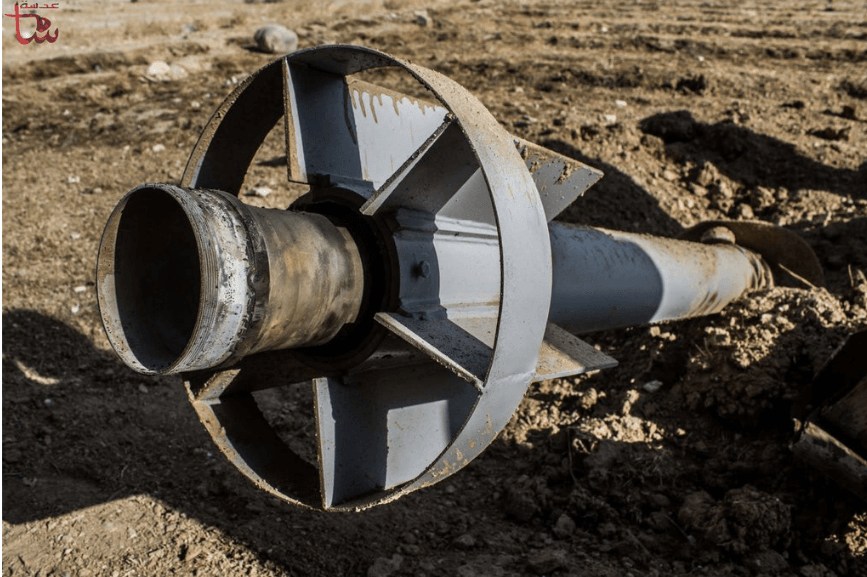
History & Context
Volcano rockets – initially referred to as UMLACAs (Unidentified Munitions Linked to Alleged Chemical Attacks) – were first seen in use by Syrian loyalist forces in December 2012 in the opposition-controlled Damascus suburb of Darayya. 12 Before the outbreak of the Syrian war, there were no documented uses of Volcano rockets in Syria. Early speculation indicates that the IRAM design may have been introduced to Syria by Iranian and Lebanese Hezbollah advisors. One of this munition’s high-explosive variants – the 107mm Volcano rocket – was widely used by Hezbollah and its local affiliates in the battle of Qusayr in early 2013. 13 Despite the Syrian government’s claims of innocence following two recorded chemical attacks using Volcano rockets in 2013, the Assad regime eventually declared chemical-variant Volcano rockets as part of its disarmament process later that year.
On 21 August 2013, the chemical Volcano rocket was used to release deadly Sarin in the now-infamous chemical attack in the Ghouta area of Damascus, which injured approximately 9,400 people and killed at least 1,242 more. The United Nations team who visited Ghouta in the aftermath of the attack identified exploded surface-to-surface rockets that were approximately 360 millimeters in diameter at two different impact sites. Each rocket’s warhead was capable of carrying an estimated 50 to 60 liters of Sarin. 14 The UN team confirmed that the victims’ injuries matched those inflicted by chemical agents, and were not congruent with damages caused by high-explosive or incendiary weapons. 15 Human Rights Watch established that such an attack would require large amounts of nerve agent, “dangerous” procedures to load the warheads with the chemical agent and specialized launchers to fire the rockets. 16
The chemical attack in Ghouta was eventually attributed to the 155th Brigade of the 4th Armored Division, a Praetorian formation loyal to the Syrian government and commanded by President Bashar al-Assad’s brother, Maher al-Assad. One of the munitions in this attack was likely fired from just north of East Ghouta – the location of the 155th Brigade Missile Base near the Mezzeh Military Airport. 17
Our research suggests that an earlier attack involving a Volcano rocket carrying Sarin likely took place on 5 August 2013 in ‘Adra, Damascus, which injured 25 people. 18 While no other chemical attacks involving this munition type have been recorded, high-explosive versions of the Volcano rocket have been spotted in multiple videos shared by pro-government and armed group sources. The 107mm Volcano rockets were used during the Barzeh offensive in April 2013, and larger Volcano rockets were widely deployed in the Yabroud offensive in mid-March 2014.
M-14-S Artillery Rocket
The M-14-S artillery rocket and chemical warhead are BM-14 multiple launch rocket systems (MLRS) commonly mounted on the back of a truck by Syrian government forces. While the use of M-14-S rockets on the battlefield is well-documented, there is only one record of the Syrian government deploying its chemical variant.

Physical Characteristics
The spin-stabilized 140mm M-14-S artillery rocket was originally manufactured by the Soviet Union. The light-gray colored 140mm rocket comes with three types of warheads: the M-14-OF high-explosive fragmentation warhead; the M-14-D warhead containing white phosphorus; and the M-14-S chemical warhead carrying up to 2.2 kilograms of Sarin. These munitions have a minimum range of 3.9 kilometers and a maximum range of 9.8 kilometers. The M-14-S artillery rocket measures approximately 630 millimeters in length (including its warhead at the front, motor in the middle and nozzle at the end) and 140 millimeters in width. 19
This chemical munition has ten exhaust nozzles ordered in a circle at its base with a metal electrical contact plate in the center. These design features are distinctive markers of Soviet-made 140mm rockets. Another clear indicator of this rocket’s Soviet craftsmanship is the “179” factory markings found on the casing of an expended M-14-S rocket recovered from the site of the 21 August 2013 chemical attack on Mu'addamiyat ash Shaykh, West Damascus. This engraving refers to Factory 179, one of the largest producers of artillery and rockets during the Soviet era – including the 140mm M-14-S rocket. 20 These artillery rockets also have Cyrillic engravings on the bottom ring of their engines, such as “Г И Ш 4 25 - 6 7 - 179 К”.
M-14-S artillery rounds are a well-documented part of the Syrian government’s arsenal. Several sources indicate that 200 BM-14 systems – the most common launchers for 140mm M-14-S rockets – were designed in the 1950s and sold to Syria by the USSR between 1967 and 1969, likely along with stockpiles of this munition type. 21


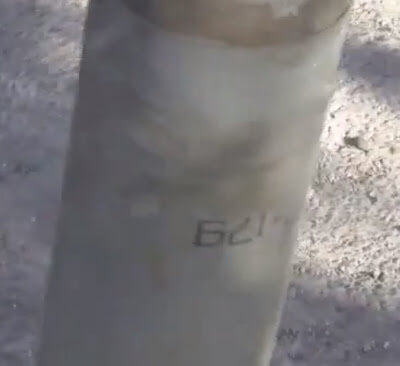
History & Context
The use of 140mm M-14-S artillery rockets was confirmed in the chemical attack in Mu'addamiyat ash Shaykh on 21 August 2013. 22 This chemical weapons attack resulted in 105 recorded deaths and injured at least 1,226 people. The UN inspectors who recovered and examined the expended 140mm rocket found at the site concluded that the warhead had detached from the rocket upon impact, spreading the odorless Sarin agent. The symptoms and injuries described in the witness statements were consistent with those resulting from a chemical agent warhead rather than from a high-explosive or incendiary payload.
The 140mm M-14-S rocket used in the attack on Mu'addamiyat ash Shaykh was likely launched from an area that houses multiple Syrian government military bases, training facilities, surface-to-air missile sites, the headquarters of the 4th Armored Division (located only 7 kilometers from the attack site), and the eastern section of the Mezzeh Military Airport (roughly 4 kilometers from the attack site). 23 The BM-14 launcher system is most likely the vehicle that shot the rockets. This attack was the first – and so far only – known instance of this munition type carrying chemical weapons.
Barrel Bomb
Variants of so-called barrel bombs – improvised aerial bombs carrying gas canisters instead of high-explosives and shrapnel – have been the most widely-used chemical munitions employed by the Syrian government throughout the conflict.

Physical Characteristics
Improvised air-delivered chlorine munitions are one variant of the barrel bombs used by Syrian government forces since at least August 2012. Instead of high explosives and shrapnel, chemical barrel bomb payloads consist of industrial gas vessels lodged inside either metal drums or welded cages. According to the OPCW, no fewer than seven distinct types of chlorine-filled barrel bombs have been identified in Syria since their initial appearance in 2014.
The chlorine barrel bomb’s most recent iteration has been in use since at least August 2016. 24 This munition consists of a single yellow standard industrial chlorine cylinder welded into a steel cradle. The chlorine barrel bomb’s design also includes four stabilizing tail fins, two carrying lugs for easier loading and transportation, (in some instances) a nose cone, and two small sets of wheels. Since these barrel bombs are commonly deployed two at a time, the added wheels allow for easier dispatch off a ramp installed in the back of Mi-8/17 helicopters. Remnants and intact munitions recovered from sites across four governorates in Syria, including two besieged pockets, show a consistency in design and production that is indicative of factory production.
In contrast to previous barrel bomb iterations, the current high-pressure cylinder is designed to rupture upon impact without the help of added explosives. According to expert assessments from Armament Research Services (ARES), each air-delivered chlorine munition has a usable volume of 50 to 60 liters, which can hold around 71 kilograms of liquefied chlorine. 25 This equates to roughly 22 cubic meters of pure chlorine gas, or up to 27,500 cubic meters of chlorine dispersed in the air at the lethal concentration of 800 parts per million. Theoretically, this amount would be sufficient to engulf an area of 120 by 120 meters at ground level.

Earlier iterations of the chlorine-filled barrel bombs in use since spring 2014 commonly involve gas canisters of various sizes lodged into oil drums and other barrels. Their construction is similar to those munitions using high-explosive payloads. In order to ensure the rupture of the gas containers, these munitions are usually fitted with an impact plate, fuse and detonator, which run the risk of failure or burning up the chemical agent. In some cases, payloads were also reported to include small bottles of flask with a second chemical, which experts speculate to be potassium permanganate.
Despite the inclusion of tail fins, chemical-filled barrel bomb munitions have proven nearly impossible to target accurately. Even if it were possible to consistently hit the intended targets with precision, the chemical payload itself would disperse in an indiscriminate fashion. The introduction of man-portable air-defense systems (MANPADS) into rebel arsenals after 2013 pushed Syrian pilots to fly over rebel airspace at increasingly high altitudes. Syrian air force pilots are instructed to fly at least 3,000 meters overhead, further complicating the task of purely visual targeting. 26 A brief OPCW-UN review of munition impact sites in multiple heavily targeted towns in Northwest Syria failed to identify any discernible patterns in targeting, rather pointing to specific incidents as the result of city-wide targeting. 27
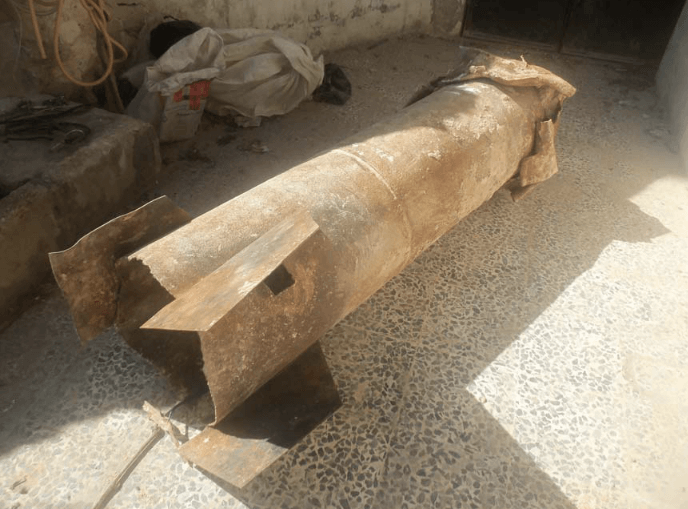


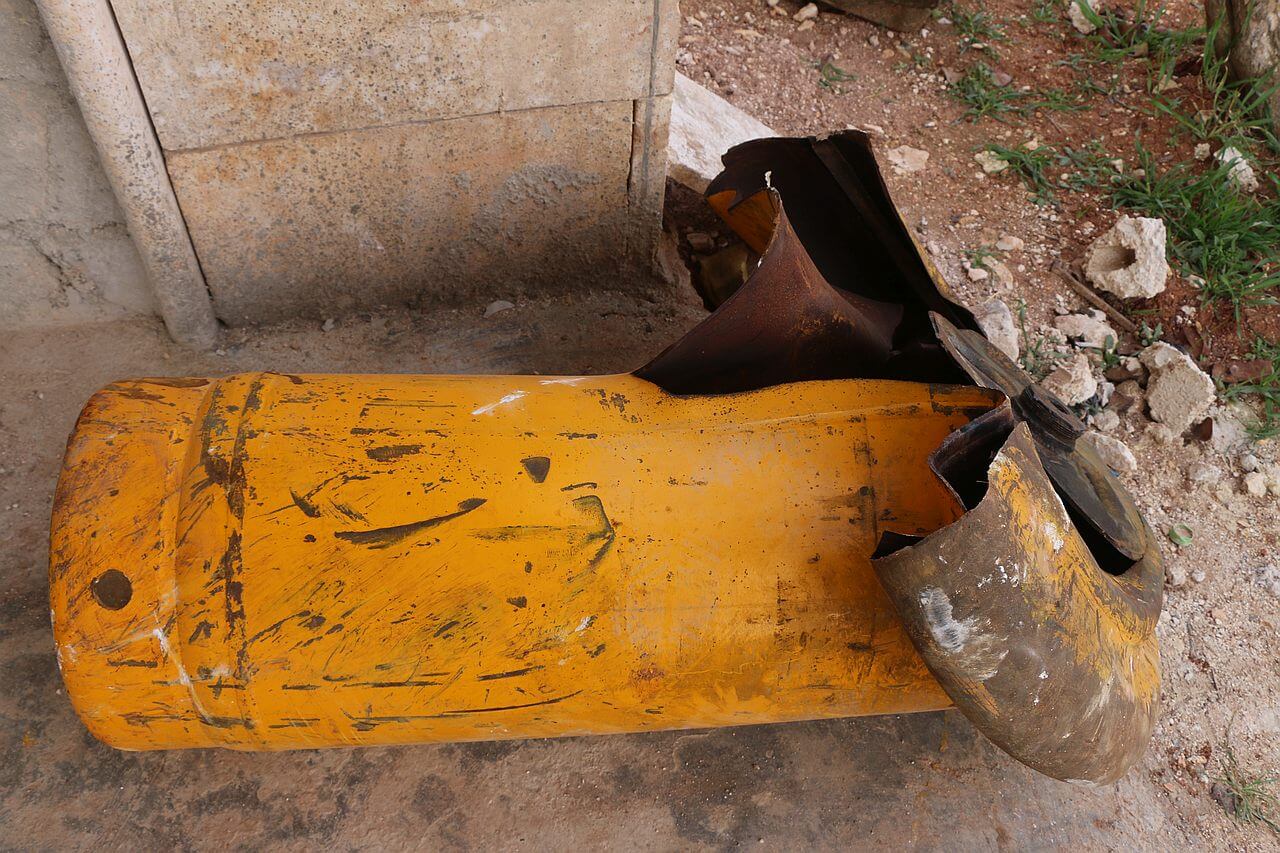


History & Context
According to our research, chemical attacks involving chlorine-filled barrel bombs account for an estimated 90% of all chemical weapons used throughout the Syrian conflict. In spring 2014, Syrian Arab Air Force (SyAAF) helicopters launched at least 38 chlorine attacks against villages in the northern Hama governorate along the M5 highway. Since then, our research team has collected information on at least 132 confirmed incidents involving chlorine barrel bombs across seven governorates. However, despite their prevalence, these munitions have received little international attention. Early iterations of chlorine barrel bombs first appeared in spring 2014 – half a year after the fateful “red line” moment following the 21 August 2013 attack in Ghouta and well into Syria’s official disarmament process. 28
Operationally, the use of chlorine-filled barrel bombs is closely associated with a small detachment of six to eight specially configured Mi-8/17 Syrian helicopters, formally affiliated with the 63rd Brigade of the SyAAF based out of Hama Air Base. However, in practice, this helicopter fleet is commanded by Brigadier General Suheil al-Hassan’s Tiger Forces. Recently rebranded as “Division 25”, the Tigers have long stood accused of pioneering the systematic use of barrel bombs in the early years of the war. In 2017, more than 40 UN member states identified al-Hassan as the commander of the first major chlorine bombing campaigns in 2014 and 2015, 29 and he was recently identified by the OPCW IIT as most likely responsible for the use of chlorine barrel bombs in early 2018.
Similar to their conventional progenitors, the origin of the chlorine barrel bomb’s designs can be traced to the secretive Branch 797 of the Syrian Scientific Research Center’s engineering division near Masyaf, Hama. According to multiple reports, production on these munitions took place at the Syrian government’s Zawi factories. Other accounts point toward Branch 797’s previous seat at the Safira Defense factories in southern Aleppo as the central hub for barrel bomb production, at least early on in the war. Based on satellite imagery taken of airfields just prior to chemical attacks, investigators now speculate that chemical munitions (at least in their latest iteration) are likely assembled at mobile facilities located at the dispatching air base.
Golan Rocket
So-called Golan rockets are a type of locally-produced, improvised surface-to-surface munitions used throughout the war by Syrian government forces – particularly by the 4th Armored Division.

Physical Characteristics
This improvised munition type is based on Iranian-made 107mm surface-to-surface rockets, although this munition swaps out the high-explosive warhead for a pressurized cylinder filled with industrial chlorine. According to Armament Research Services (ARES), the Golan rocket’s design can be traced back to conventional IRAM munitions used by Hezbollah and Iranian-linked groups in Iraq in the mid-2000s. 30 The payload cylinder is fabricated from steel and is between 60 and 400 millimeters in length and 220 and 250 millimeters in diameter – large enough to deliver up to 7.5 cubic meters of chemical agent. The nose of the cylinder is fitted with a filling valve, while its base is equipped with two “twin well” time-fuses. The payload cylinder is attached to a 107mm rocket motor and six fins are affixed to the motor’s base in an attempt to stabilize the rocket’s body during flight.
While the warhead is likely constructed locally in Syria, the rocket motors are imported and carry standard production markings. The 107mm Golan rocket motors recovered in the aftermath of the chemical attacks in early 2018 all came from the same lot manufactured in Iran in 2016. 31
Both the conventional and chemical variants of this IRAM are fired from multiple-barreled rocket launchers (MBRLs) designed for area saturation, often in salvos of three to ten rockets. Weapons experts from ARES estimate that Golan rockets have a maximum range of around 2 kilometers. However, the assembly requirement for this munition type and its poor aerodynamic design make Golan rockets both inaccurate and imprecise.
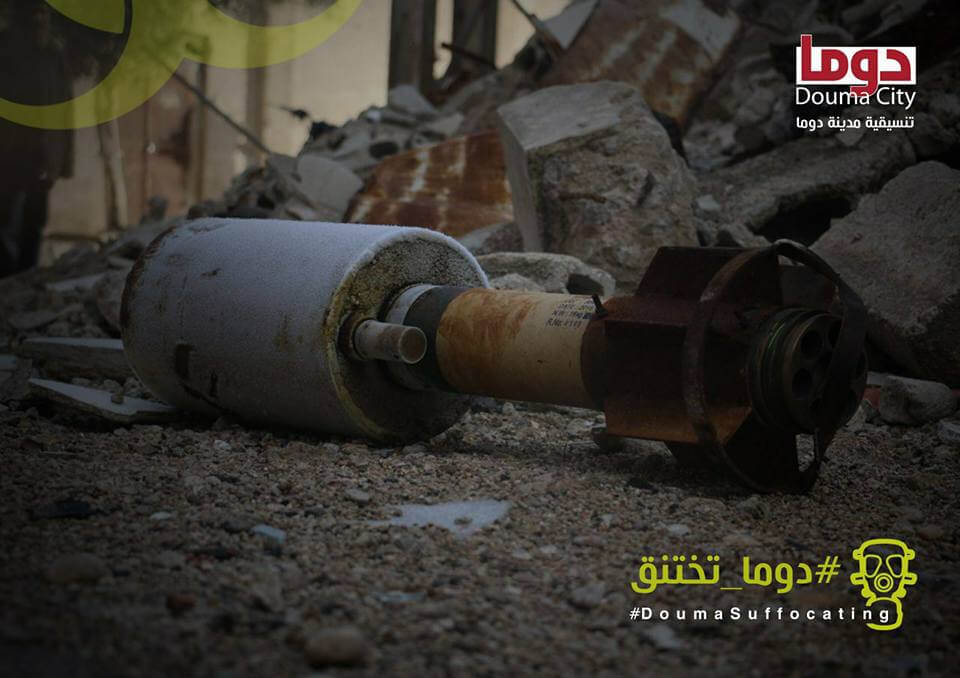

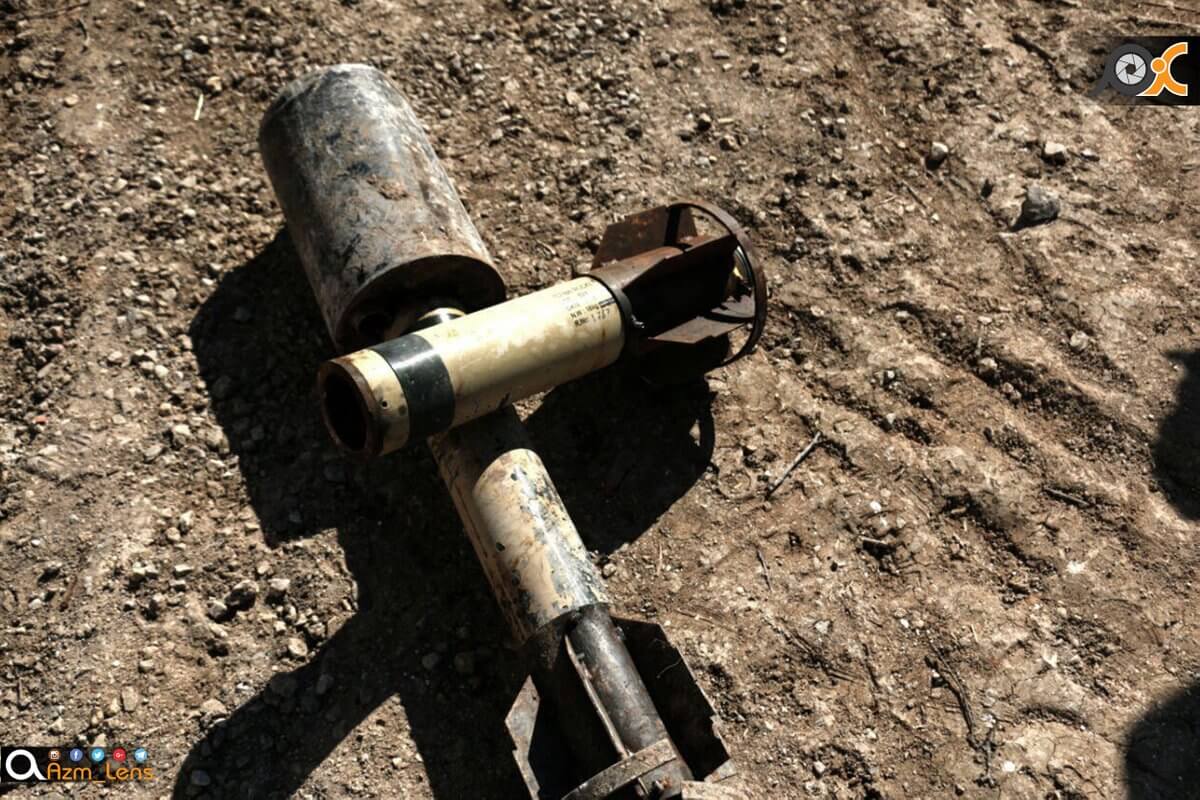
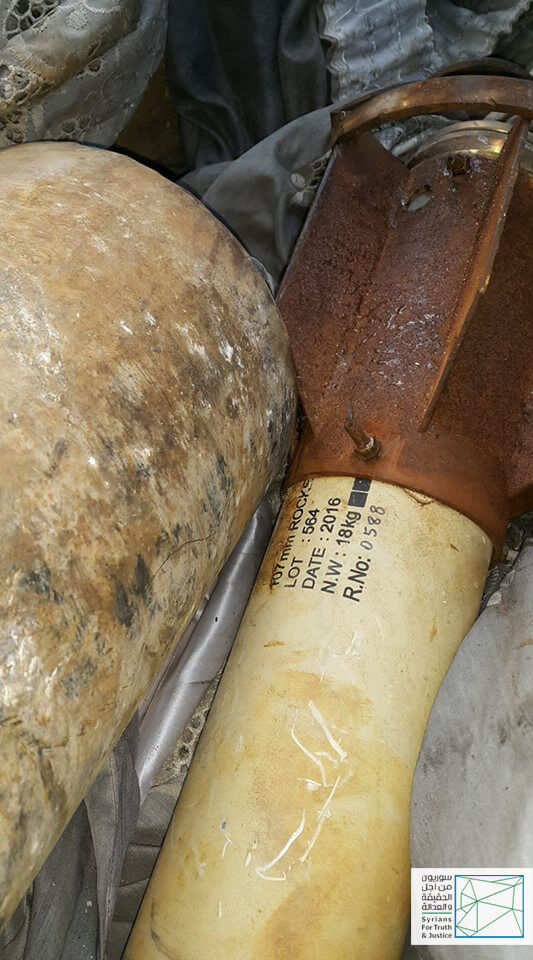

History & Context
The conventional version of this IRAM is locally known as “Golan-65” and is primarily used by the Syrian Army’s 4th Armored Division – a key Praetorian formation responsible for the protection of the Syrian regime and associated with Maher al-Assad, President Bashar al-Assad’s brother. The 4th Armored Division collaborates closely with Iranian advisors and Lebanese Hezbollah militias in Syria.
Five incidents involving chlorine-filled Golan rockets were recorded in the eastern outskirts of Damascus in 2017 and 2018. Four of these attacks occurred in Duma as part of the campaign against East Ghouta – an area that was an active target of the 4th Armored Division. 32 Only one incident occurred away from the capital and deep in the Latakia Mountains in 2019 during the Battle of Kabani. Open-source analysis of the likely launch point of the chemical rockets connects the attack to a unit of the 4th Division that had previously fought around Damascus. 33
M4000 Aerial Bomb 34
The M4000 is the only non-improvised aerial bomb in the Syrian government’s arsenal used to deliver the chemical agent Sarin. The recovery of M4000 bomb remnants at three chemical attack sites in spring 2017 directly contradict the Syrian government’s claims that it had declared and relinquished its entire stockpile of chemical agents and munitions in the preceding years.

Physical Characteristics
The M4000 bomb is an unguided aerial munition produced in Syria for the delivery of chemical agents, specifically binary Sarin. The munition’s basic design derives from Soviet-era conventional aerial bombs, with some adjustments to accommodate the chemical agents. 35 According to the OPCW, the M4000 bomb weighs approximately 350 kilograms, is 460 millimeters in diameter and approximately 1,470 millimeters in length. Internally, the bomb consists of two distinct chambers carrying the primary precursors of binary Sarin – methylphosphonyl difluoride (DF) in the front chamber and isopropyl alcohol and hexamine in the rear. 36 The two chambers are separated by a thin partition made up of two mica discs and a ring. 37 At the top of each chamber is a filling plug sealed with a cap, which is next to two suspension lugs used to attach the munition to an aircraft. The rear chamber of the bomb contains a mixing arm that can be activated via a crank on the outside of the munition. This arm is designed to pierce the partition between the two chambers and mix their components before the M4000 bomb is loaded onto an aircraft. 38
The front cone of the M4000 bomb is made of a thick material to align the bomb in flight. The tip of the bomb contains a fuse – identified as the Russia АВУ-ЭТ impact fuse – that is connected to a fuse adaptor. 39 The entire fuse structure is connected to a burster tube designed to carry trinitrotoluene (TNT), which is housed within the front chamber. In the recorded Sarin attacks using M4000 bombs, each burster tube carried around 3 kilograms of TNT. 40 TNT is used to force the munition open and allow the contents – in this case, Sarin – to escape without burning up the chemical agents. 41
The tail structure on the outside of the bomb’s rear end is made up of an inner metal ring connected by eight metal structures to a larger outer ring. The eight connecting structures include four rectangular pieces and four longer, triangular pieces – the tail fins – alternating between one another. 42 In its full form, the entire tail structure measures 900 millimeters in width 43 and is designed to stabilize the munition’s landing. 44 The M4000 bomb’s tail fins do not extend outside of the tail ring as in the MYM6000 aerial bomb’s design. 45 In addition, metal rails with equally distributed holes on the outside structure appear to bolt together the different parts of the bomb. 46
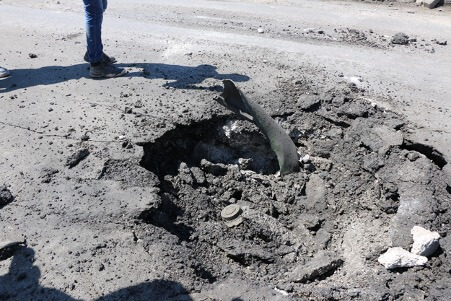

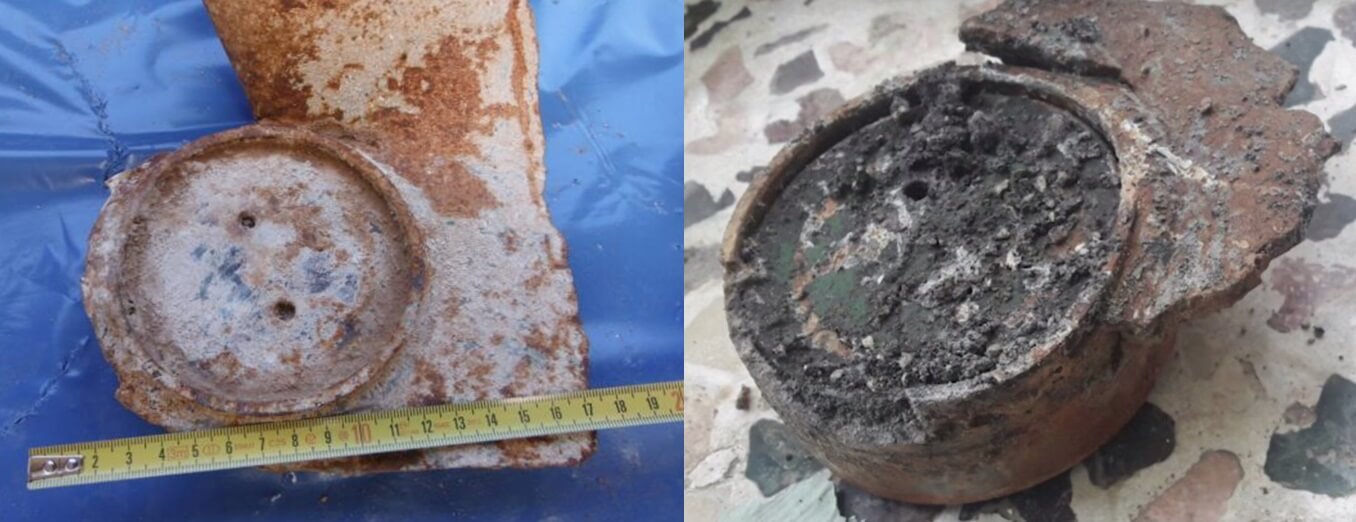

History & Context
In 2017, the Syrian Arab Air Force (SyAAF) deployed M4000 aerial bombs in at least three separate Sarin attacks within a period of ten days in the northern Hama and southern Idlib governorates. The first two attacks took place in Al Lataminah on 24 March and 30 March 2017, and the third attack was recorded in Khan Shaykhun on 4 April 2017. Similarities in the attack patterns suggest that Syrian government forces may have also deployed M4000 bombs in a series of ISIS-held areas in the eastern Hama governorate in December 2016, although no visual evidence has emerged from these attacks.
According to the OPCW as well as media reporting, the attacks in Al Lataminah and Khan Shaykhun were conducted by the 50th Brigade of the SyAAF’s 22nd Air Division. In each attack, the M4000 bomb was delivered by a Su-22 (“Fitter”) aircraft originating out of Shayrat Air Base and flown by the squadron commander. 47 All three attacks exhibited great similarity.
For further details on this attack and related incidents, see our report on the Syrian Arab Air Force.
To explore all 349 confirmed incidents, visit the Data Portal.
Syrian Air Force
chevron_leftData Portal
chevron_right- play_arrow Munitions Typology:Introduction